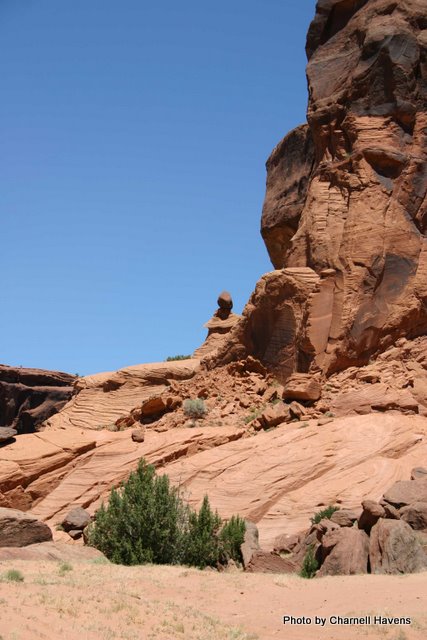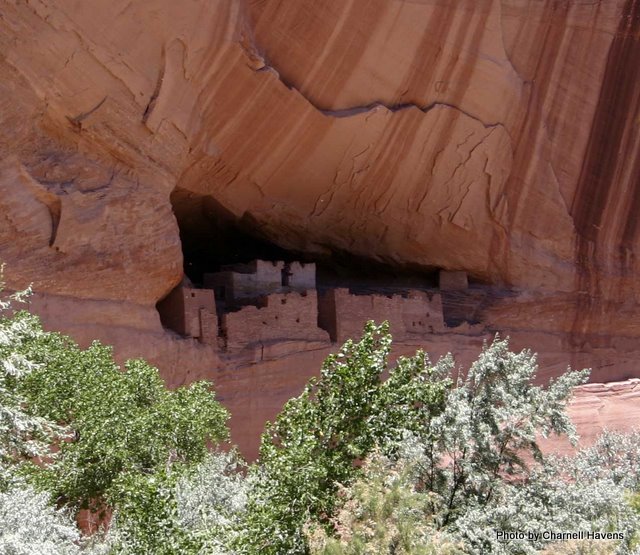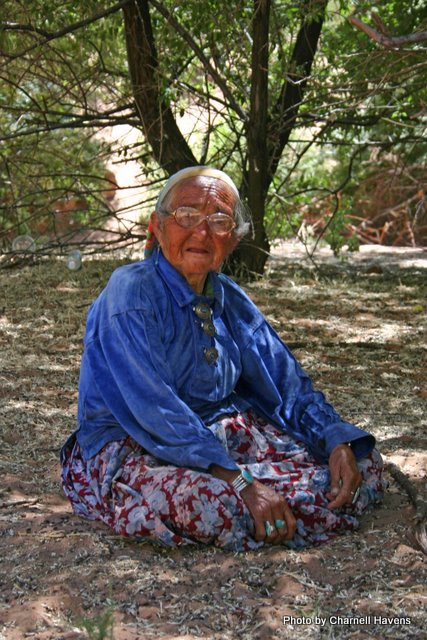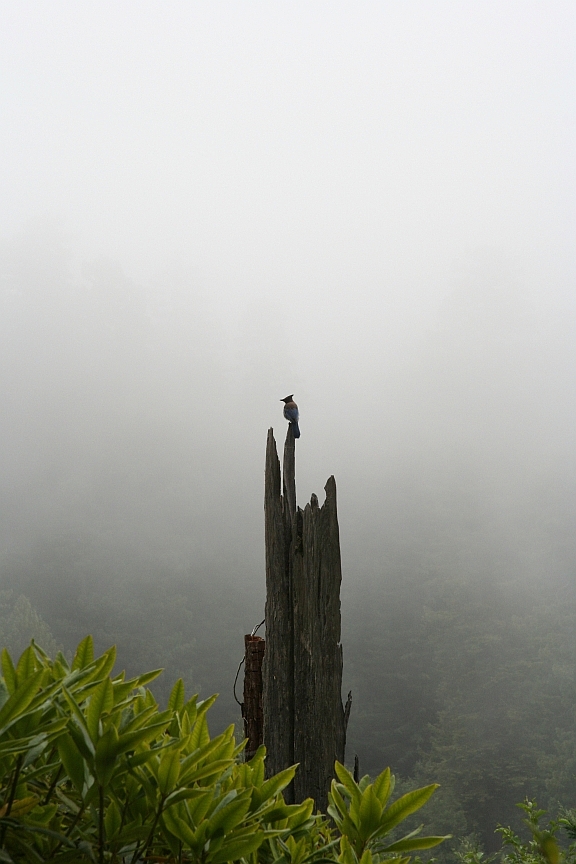Canyon de Chelly, AZ, USA
Today's post is by Vera Marie Badertscher (pictures by Charnell Havens) and should probably have been titled something like "Amazing Navajo Art and Tradition" or "The Natural Beauty of the American Southwest," but I could not pass up the opportunity to be silly. You see, the very first photo is of a place known as "Spider Woman Rock." I think we can all agree that Spider Man has already had his share of the hype. It really is time to give Spider Woman her due — she rocks! (Btw, most captions are by me. You know, just to avoid any confusion. :)
Like so many place names in the west, this canyon on the Navajo reservation started out with a mispronunciation. Canyon de Chelly, with its towering red rock walls and evocative ancient ruins, is my very favorite place in Arizona. The name is the Spaniard's version of the Navajo word tsegie (canyon), and is pronounced "de Shay." This canyon, co-managed by the United States Park Service, actually belongs to the Navajos and many families live here in the summer—leading their horses and sheep up on the rim or to nearby Chinle in the winter time.
Spider Woman Rock
Huge cottonwood trees shade the walks that lead from comfy cabins to the plain-jane cafeteria at Thunderbird Lodge. Nearby at the National Parks Service visitor center you can hire a Navajo guide if you want to use your own vehicle to explore rock formations and ancient pueblos in the canyon. On our first trip, we opted for the open-truck bed seating of the tours that leave from Thunderbird Lodge. Each truck is driven by a Navajo guide. Navajos can have a wicked sense of humor, and particularly enjoy pulling the wool over the eyes of unsuspecting tourists, so I decided to play along. I asked the group of driver/guides, “So which of you tells the best stories?” The lanky young men in Levis shuffled their cowboy boots in the dust and grinned, looking at each other. One said,
“That guy over there—he's a Pima.” They thought they had a tenderfoot who didn't know one tribe from another. Ha! “Oh, really?” I said innocently, “I live next door to the Pima reservation in Scottsdale. Maybe I know some of your relatives.” They cracked up—BUSTED!
Would you want to leave such beauty?
The Navajo guy in question lived in Canyon de Chelly. I sat in the cab of the truck with him and in between his bad jokes on the microphone– “That there is called 'Martini Rock'” he said of an overhang. “One drop will kill you”– he filled me in on real stories. He told the tourists the story of the way that Kit Carson had chased the Indians living here, rounding them up to go on the Long Walk away from their reservation. Several of the elders took refuge on top of one of the mesas preferring to starve there in their homeland.
This alone makes me want to go there. Amazing!
When he turned off the microphone, I asked if he had ever gone up there. “No,” he told me quietly. “I would be afraid to go there. It is a sacred place.” The Navajo have an uneasy relationship with death. In the old days white traders would be enlisted to take bodies out and bury them because the Navajo wanted nothing to do with the dead spirits.
Ford take note: this is what REAL mustangs look like!
Later as we drove along through the river bed that forms the “road” through the towering red walls of the canyon with their black “desert varnish” stains, he pointed out to me where his uncle lived, and where his family home and corral stood.
Watching her sheep.
While the younger generation are thoroughly modern with their pick up trucks and cell phones, traditions run strong here, and many of the older generation still speak only Navajo, a language I have struggled in vain to pick up. While I make it a habit to learn basic pleasantries in the language of any country I visit, in Diné Bikeyah, I have only conquered “Yah-ta-hey” (hello) and hozho– a blessing wishing you beauty and harmony—the highest value of the Navajo.
Charnell Havens and Vera Marie Badertscher wrote Quincy Tahoma: The Life and Legacy of a Navajo Artist, now available at independent book stores, art galleries, museums, and on their blog site. The book tells the life story of Quincy Tahoma (1917-1956) and includes 260 images. Badertscher also blogs about books and movies that influence travel at A Traveler's Library.






Stunning photography. What a beautiful place to spend some time.
Angela: I hope you get to go there! Your comment is linked to St. Peter’s Basilica, and Canyon de Chelly is another kind of holy place.
Beautiful pictures, I had never heard about this place, you made me want to go!
Just fascinating, and gorgeous photos. And being a movie girl, anything with Spider Woman in the title draws me right in.
Thanks again for all the enthusiastic comments. I hope you all get a chance to visit Canyon de Chelly. There is definitely something magical about the place. Mesa Verde is indeed awesome, but the Navajos and their horses in Canyon de Chelly make it such a different experience. The contrast between past and present is striking.
I’ve never been, but my hubby has. He loves it there. I’ve only seen the cliff dwellings at Mesa Verde. Very neat.
Fun read–and to hear how you got a “real” tour.
Thanks NPC and Jeanine. Indeed, this is Navajo land and it seems a little strange to talk about it without recognizing that fact.
What a lovely post. I’ve visited Canyon de Chelly and you both have certainly captured the spirit of this place by focusing in on the Native Americans. So many visitors seem to forget that the land belongs to then.
Very good point, Jeanine. In my mind, I still consider that the whole continent rightfully belongs to First Nations people. Although as I understand it, the idea of land “ownership” is something that doesn’t really apply to many native cultures. :)
THese photos are amazing. We are actually visiting Arizona this summer, but unfortunately not this area! Now I wish we were!
Agreed! My husband has only been to the US once, and we only had time for the west coast. There is so much more to see. I think we might need to devote a month just to Arizona at some point!
Just coming back to subscribe to comments
Glad you all enjoyed it. I agree, Kris, there is a similar thread that ties together the indigenous people, tending to be closer to the earth and closer to their “core beliefs”
And Casey and Sophie–we love to tell these stories particularly for people who have never ventured into Navajo land.
Vera and Charnell, you’re such an amazing team. Through your words and pictures, you really capture the beauty of this part of the country.
I must agree, Casey! Now when I look out the window on a cold, Irish day, I can close my eyes and imagine myself somewhere much warmer and more colorful! ;)
Looks like a fascinating and beautiful place. Esepcially intrigued to hear about the Spider Woman.
Hi, Sophie! I found Spider Woman fascinating, too. Would love to read a fictionalized book based on the stories about her, in fact. Maybe some day Vera will give it a go. ;)
I see such similarities between the native American people you write about and the Hawaiian people I know. There is such honor among them, such humility.
Hi, Kris and thanks for commenting! While I tend to shy away from characterizations like this (it’s a fine line, and a personal one for me), I appreciate what you’re saying. I enjoy learning about people around the world and how we all seem to be more similar than different. :)
Katrina: Thanks so much for sharing this with people. It is definitely our favorite place on the beautiful Navajo reservation, and we want to encourage people to visit, but also, of course, to read about Quincy Tahoma, the Navajo artist!
I should have explained that Spider Woman is one of the most important people in the legends of the Navajo people, for many reasons, but mostly because she taught them to weave. (of course.)
Vera, thank you again for the post. Please thank Charnell for the photos as well. I always welcome the chance to learn about cultures and traditions. :)